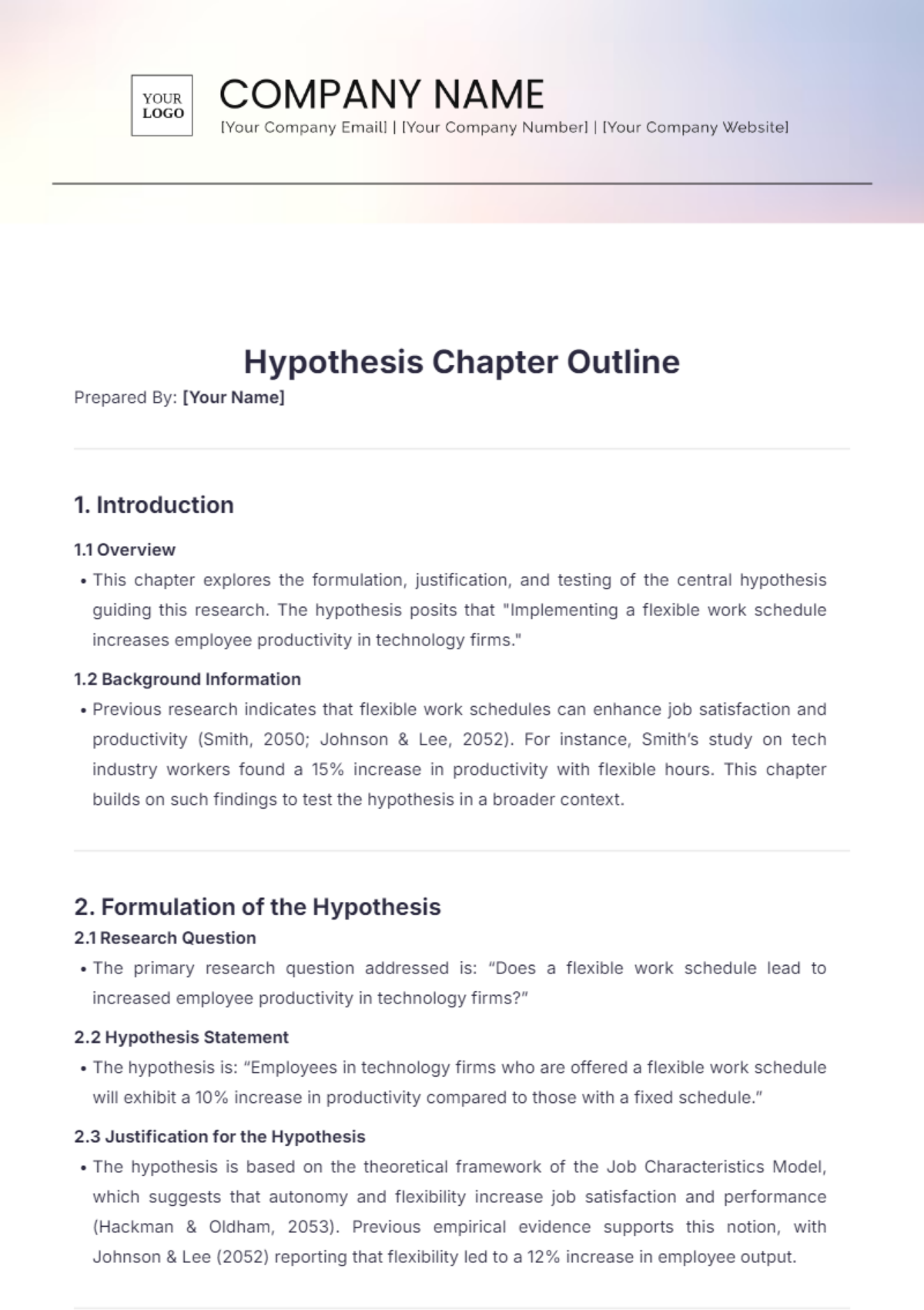Literature Review Chapter Outline
Prepared By: [YOUR NAME]
Date: [DATE]
I. Introduction
A. Overview of the Topic
This literature review explores the impact of artificial intelligence (AI) on healthcare delivery systems. AI technologies, such as machine learning algorithms and natural language processing, have revolutionized diagnostics, treatment planning, and patient care.
B. Importance of the Literature Review
Conducting a literature review is crucial for understanding the current advancements in AI applications in healthcare. It highlights how these technologies improve patient outcomes and efficiency, and identifies areas where further research is needed.
C. Scope and Objectives
The review covers studies published from 2080 to 2094, focusing on AI applications in diagnostic imaging, electronic health records, and personalized medicine. The objectives include synthesizing current findings, evaluating the effectiveness of AI technologies, and identifying research gaps.
II. Theoretical Framework
A. Historical Context
The theoretical foundation of artificial intelligence in the healthcare industry can be traced back to the early developments of expert systems that emerged during the 2050s. As time progressed, significant strides in the enhancement of computational power, coupled with the evolution and refinement of algorithms, have considerably broadened the scope and applications of artificial intelligence within the medical field.
B. Key Theories
Theory A (Machine Learning): Machine learning algorithms, such as supervised and unsupervised learning, have become central to AI applications in healthcare, enabling systems to learn from data and improve over time.
Theory B (Natural Language Processing): Natural language processing (NLP) facilitates the interpretation of clinical narratives, improving information retrieval and patient interaction.
Theory C (Predictive Analytics): Predictive analytics uses historical data to forecast patient outcomes, aiding in early intervention and personalized treatment plans.
C. Application
Machine learning models are commonly used in diagnostic imaging to accurately detect anomalies, helping healthcare professionals make better diagnoses, while natural language processing (NLP) tools analyze electronic health records to extract important information for clinical decision-making.
D. Comparative Analysis:
Comparing supervised learning with unsupervised learning reveals that supervised methods, while more accurate in specific tasks, require labeled data, whereas unsupervised methods can identify patterns without prior labels.
III. Methodology
A. Search Strategy
Databases: The review of existing scholarly and scientific literature was conducted utilizing three primary databases: PubMed, the IEEE Xplore digital library, and Google Scholar.
Keywords: The keywords that were included comprised artificial intelligence in healthcare, machine learning diagnostics, and predictive analytics in medicine.
B. Inclusion and Exclusion Criteria
Inclusion Criteria: Studies published in English from 2080 to 2094, peer-reviewed, and focused on AI technologies in healthcare settings.
Exclusion Criteria: Studies that are either not related to the applications of artificial intelligence in the field of healthcare or those that were published before the year 2080.
C. Data Extraction
Data was meticulously gathered through the utilization of a standardized form, designed to capture various elements of the studies, such as their objectives, the methodologies employed, the results obtained, and the conclusions drawn. This comprehensive extraction process entailed a thorough review of both the abstracts and the full texts of the studies to ascertain their relevance to the research objectives.
D. Quality Assessment
The quality of the studies included in the review was evaluated using the Critical Appraisal Skills Programme (CASP) checklist, a comprehensive tool that assessed key aspects such as study design, sample size, and statistical analysis to ensure robust methodologies, sufficient sample sizes, and valid, reliable findings.
IV. Key Themes or Topics
A. Theme 1 (AI in Diagnostic Imaging)
Description: AI algorithms have significantly enhanced diagnostic imaging by improving image quality and accuracy in detecting conditions such as tumors and fractures.
Examples: Research by Smith et al. in 2080 and Lee et al. in 2081 demonstrates that artificial intelligence technology has improved diagnostic accuracy in mammography and radiology, offering valuable insights into the effective use of AI in these medical fields.
B. Theme 2 (AI in Electronic Health Records)
Description: Artificial intelligence systems are utilized to analyze electronic health records, also known as EHRs, to streamline the process of data entry. In addition to this, these systems are employed to identify trends within the data, and they provide support to healthcare professionals in making informed clinical decisions.
Examples: According to research conducted by Wang and colleagues, published in the year 2080, artificial intelligence plays a significant role in predicting patient readmissions by analyzing electronic health record data.
C. Theme 3 (Personalized Medicine):
Description: AI technologies advance personalized medicine by analyzing genetic data to create customized treatment plans. These systems use algorithms to interpret genetic information, predict disease risk, and recommend tailored therapies, optimizing treatment and reducing adverse effects.
Examples: Johnson et al. (2083): Explores AI-driven genetic analysis for personalized cancer treatments, demonstrating improved outcomes through tailored therapy recommendations based on genomic data.
D. Additional Themes
Theme 4 (Ethical Considerations): This theme covers ethical issues in AI healthcare applications, including data privacy, algorithmic bias, and potential discrimination. It discusses the need for ethical guidelines to ensure patient rights, fairness, and transparency.
V. Discussion of Findings
A. Synthesis of Key Findings
The extensive evaluation indicates that adopting artificial intelligence (AI) technologies significantly improves diagnostic precision and operational effectiveness in healthcare settings; however, significant issues remain, including data privacy concerns and the necessity for strict validation procedures to guarantee the reliability and safety of AI in medical applications.
B. Comparative Analysis
Research has demonstrated that diagnostics enhanced by artificial intelligence tend to surpass traditional methods in terms of accuracy. However, it is important to note that the degree of success can vary significantly based on the specific artificial intelligence system employed as well as the particular medical condition being addressed.
C. Theoretical Implications
The research findings advocate for the continuous development and integration of machine learning in healthcare, suggesting that evolving AI models are essential for managing complex medical situations and that advancements in technology are crucial to maintaining these models' effectiveness and precision in diverse medical contexts.
D. Practical Implications
The incorporation of artificial intelligence into healthcare practices has the potential to result in significantly more accurate diagnostic procedures and the development of treatment plans that are tailored to the individual needs of each patient. This advancement holds the promise of revolutionizing patient care and streamlining medical workflows, thereby creating a more efficient and effective healthcare system.
VI. Gaps in the Literature
A. Underexplored Areas
There is a notable gap in research on the use of AI in low-resource settings, where healthcare infrastructure may be limited. Additionally, studies on AI’s effectiveness across diverse populations, including various ethnic and socioeconomic groups, are sparse. This lack of research hampers the ability to generalize AI technologies' benefits and limitations in these settings.
B. Methodological Limitations
Many existing studies on AI in healthcare are constrained by small sample sizes and lack of longitudinal data. These methodological limitations restrict the ability to draw robust conclusions and may lead to overestimating or underestimating the effectiveness of AI applications. The short duration and limited scope of many studies also impact the generalizability and reliability of their findings.
C. Inconsistent Findings
Research results on AI diagnostic accuracy are inconsistent. While some studies report high accuracy and effectiveness, others reveal significant discrepancies and variations. This inconsistency suggests a need for standardized evaluation criteria and protocols to better assess and compare AI systems' performance across different studies and applications.
D. Emerging Trends
Recent advancements in AI ethics and explainable AI are becoming increasingly significant. As AI systems are integrated into healthcare, there is growing interest in ensuring these systems are transparent, fair, and accountable. Future research should focus on developing ethical guidelines and improving the interpretability of AI algorithms to address these emerging concerns.
VII. Conclusion
A. Summary
The literature review clarifies how AI is revolutionizing healthcare, particularly highlighting its key roles in diagnostics and personalized treatments, while also pinpointing significant research gaps and current challenges that hinder further advancement in these fields.
B. Implications
The conclusions drawn from the study highlight the paramount importance of ongoing advancements and rigorous assessments in artificial intelligence technologies. These efforts are essential not only to improve the quality and efficiency of healthcare delivery but also to tackle the various ethical issues that arise in the deployment of such technologies.
C. Future Research
Future research endeavors should thoroughly investigate the applications of artificial intelligence in a variety of distinct healthcare environments, meticulously address any methodological limitations that may arise, and emphasize the ethical implications associated with deploying such advanced technologies.
D. Final Thoughts
The review highlights the significant potential that artificial intelligence has to bring about a transformative revolution in the field of healthcare. However, it also emphasizes the necessity for additional research efforts to address the current challenges. Only by tackling these challenges can artificial intelligence's full range of benefits be completely realized and integrated into healthcare practices.

















































